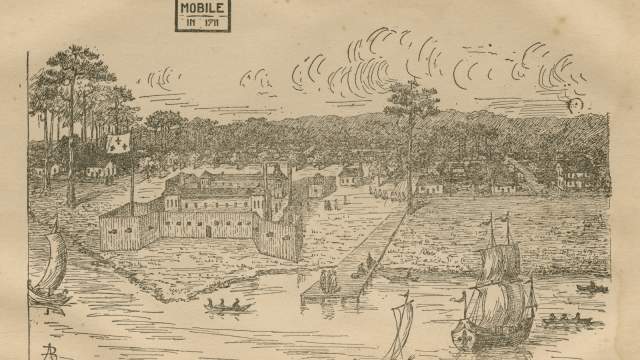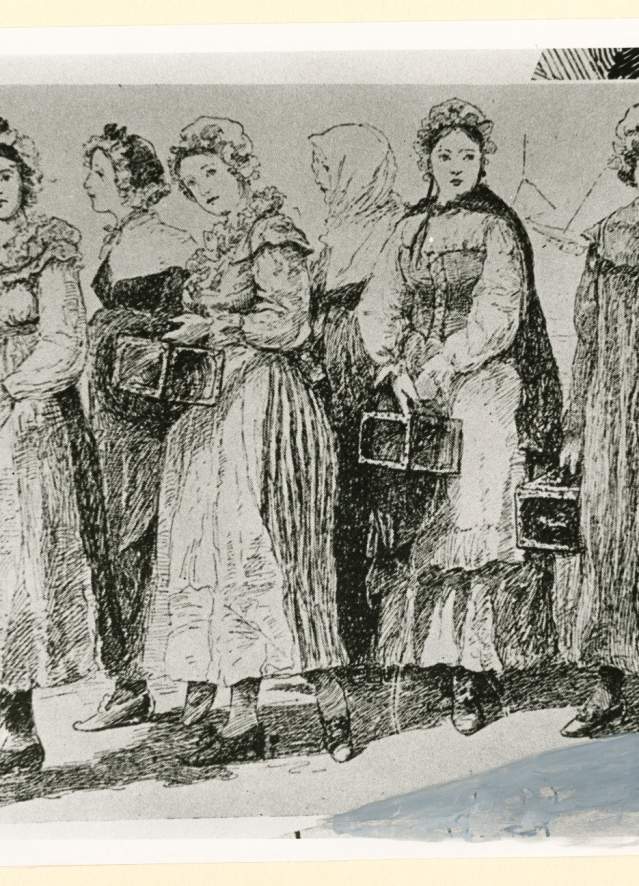The History of the Casket Girls of New Orleans
Learn the True Story of NOLA’s Original “Vampires”
The Casket Girls
What exactly are Casket Girls? While the name alone conjures images of the macabre, the filles à la cassette (women with suitcases) traveled to French colonies in America and arrived in the New World with a trunk, or cassette, containing their belongings. The word cassette morphed into casquette over time, and that translated to “casket.” History recorded these women as Casket Girls. The filles à la cassette were some of the original mothers of New Orleans. Here’s their story.
Legends of the Casket Girls
“Caskets” conjure up images quite different from a suitcase of dresses and petticoats these women were known to carry on the long voyage to New Orleans. These suitcases were relatively small, so that the women could carry them without assistance. Many of the depictions of original cassettes stretch this concept, literally, so that the suitcases appear to be large enough to carry a body. By the time the storytellers told the tale of these women, their suitcases took on a new perspective. Why did young women bring “caskets” to the new world? Did their luggage contain more than petticoats?
Paranormal Fiction writers love old New Orleans, as the city’s mix of Catholicism and Voudon influenced by African, French, Spanish, British, and Asian cultures create a perfect starting point for writers to tell vampire tales. But, before pop culture and legend turned them into vampires, the filles, like many women of the time, went through a harrowing journey that would land them in the annuls of the histories of colonial New Orleans and the world of the paranormal.

History of the Colonies and Casket Girls
The founders of New Orleans were explorers, trappers, and traders who established encampments along the lower part of the Mississippi River. The French established three main outposts along the Gulf Coast: Mobile, Biloxi, and later, New Orleans. Because the early explorers were mostly male, Catholic priests in the region became concerned that, without wives, the future of Christian evangelism in the French territory was at risk. They turned to the bishops and mayors of French port cities, who gladly agreed to empty their jails and brothels and transport these “undesirable” women to the colonies.
These “sinful” women did not make good domestic partners for the colonial men so the priests sought an alternative plan. They asked King Louis IV for assistance, and he, in turn, tasked the Bishop of Québec with appealing to convents and orphanages in France. They sought out “virtuous” young women who they could contract to come to the colonies, hoping that they would prove to be better candidates for marriage. Thus, the Casket Girls were contracted to be wives of men in the colonies.
Marriage Material
The first group of women were shipped off to Mobile in 1704 aboard the merchant ship “Pelican.” Therefore, Mobile affectionately refers to their filles à la cassette as “Pelican Girls.” A number of these women moved to New Orleans as part of a migration to the larger city over time.
The second consignment of “marriageable” women arrived in Biloxi in 1719, followed by a third in New Orleans, starting around 1728 (New Orleans was 10 years old at this time). Meanwhile, Ursuline nuns from Rouen, France, arrived in New Orleans in 1727 with the mission to educate the women of the colony and evangelize the natives. These nuns took charge of the newly-arrived filles and the women lived with the nuns until they were married off to men of the colony.
The Journey to Louisiana
First, a young woman heard of the programs to bring women to the colonies through the nuns of their convent, school, or orphanage who wanted to reduce the number of girls in their care. The women then made marriage contracts with men who arranged their trip. They traveled from their homes to port cities in France, such as Le Harve, before boarding ships to America. Once a ship had been filled, the women sometimes found themselves waiting for months for the next one.
The passage across the Atlantic took months. The ships usually stopped for supplies and drinking water in Haiti, at Cap-François (now known as Cap-Haïtien) on the island’s north coast before they pushed on into the Gulf of Mexico. The voyage was a difficult one, and many of them died from yellow fever and other travel-related diseases along the way.

New Orleans in the 1720s
When the Casket Girls arrived, Biloxi was the capital of French-occupied North America, called Louisiana or La Louisiane, while New Orleans was still an outpost. The Louisiana territory, also called New France, spanned from some of the Caribbean isles up into present-day Canada. The territory’s governor, Jean-Baptiste Le Moyne de Bienville extended his control of the Gulf Coast ordering plans and surveys of the land in the “crescent” of the Mississippi River. The city expanded out from Fort St. Charles, at what is now Esplanade Avenue and the river. Like many settlements, civilians built homes outside the fort, including a parade ground for the army troops and a parish church next to it. The French Quarter as we know it was still just a concept on paper.
Unsurprisingly, life in the French colonies was likely far less romantic than the filles had probably hoped it to be. Most of the Casket Girls didn’t see much of their spouses. These French women, once used to working in convents and orphanages, now took charge of households. The men of the colony in the 1720s-1730s were fur trappers and traders, meaning they were rarely at home. The trappers spent long periods away from home, collecting the merchandise they sold for export, whereas the traders brought manufactured goods shipped to French-colonial port cities from Europe out to the farms, plantations, and outposts to sell them.
The climate of the colony also required a good bit of adjustment for these women. The weather was hot and humid, making the clothing they brought from France likely ill-suited for their new homeland. Still, they adapted to the city as they established households and raised children.

The Ursuline Sisters
The Ursulines (otherwise known as the order of St. Ursula) founded a school almost immediately after their arrival in 1727, which many of the Casket Girls and other women attended until they married.
The city built the order’s first convent in 1734, and that building was replaced by the existing convent in 1751. The Old Ursuline Convent is the oldest building in the Mississippi Valley. It survived the fire of 1788 because of its distance from the source of the fire, which began closer to Canal Street (look up the story of Our Lady of Prompt Succor, the patron saint of Louisiana, for another interesting legend based around the Ursuline Convent). The city built the convent close to Fort St. Charles, on the eastern, downriver side of the Vieux Carré.
The Order of St. Ursula continues their mission of educating women in New Orleans to this day. While there were more Ursulines staffing elementary schools, such as St. Angela Merici in Metairie, the order focuses its efforts on their high school campus uptown.
How the Casket Girls Became Vampires
With the historical facts in mind, now it’s time to talk about the paranormal tilt of these young women’s stories. Most of the vampire-themed tales centering on the filles à la cassette focus on two things: the “caskets” and the convent. Perhaps some of the most interesting stories are those centered around the third floor of the 1751 convent building which, to this day, remains a stop on almost every haunted history tour of New Orleans.
The legend begins with the Casket Girls’ arrival in the city, and how, upon seeing the women for the first time, the men they were meant to marry found them unnaturally pale, so much so that their skin blistered and reddened beneath the subtropical sunlight within moments. The filles lived with the Ursuline nuns before their marriages occurred, but King Louis IV’s hope that these young women would be better spouses than the former sex workers and prisoners of France was in vain. Most of the Casket Girls were placed into unwanted marriages where they were mistreated by their husbands, while those left unwed were forced to find other means of survival, including prostitution. So, hearing of their mistreatment, the king ordered that these young women be sent home to France.
In preparation for their departure the cassettes, filled with all the young women’s possessions, were brought up to a room on the third floor of the Ursuline convent for storage. The third floor had always been sealed off and the windows shuttered, so it was quite a shock to the nuns when they later returned to fetch the girls’ belongings, the luggage was found empty. Even after a search of the entirety of the third floor, none of the items were recovered.
Fearing something supernatural was afoot, the nuns went out of their way to ensure nothing and no one could enter or exit the space again. While some stories say those shutters were nailed down with nails blessed by a pope, Pope John Paul II was the first pontiff to visit New Orleans in 1987, so one might assume these nails were brought to Rome for blessing, then shipped across the Atlantic. The addition of vampirism to these young women’s tale—whether the Casket Girls themselves were the vampires or their casquettes were their method of carrying vampires across the sea to the New World—is much more recent. Despite the obvious holes in the stories, many are still fun to read. Don’t pass up the opportunity to visit the Old Ursuline Convent or embark on one of the city’s haunted history tours to decide for yourself.
